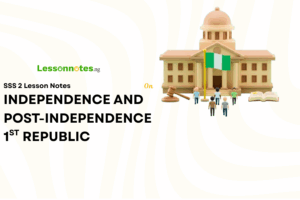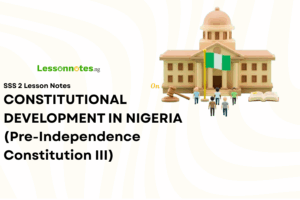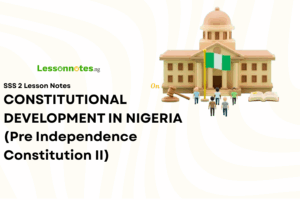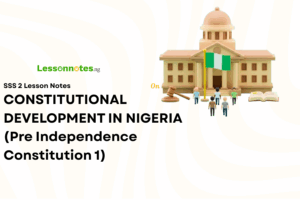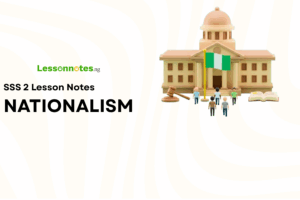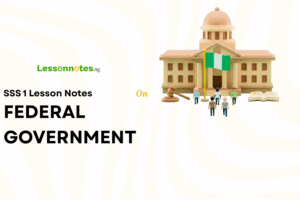Constitution And Constitutionalism SS1 Government Lesson Note
Download Lesson NoteTopic: Constitution And Constitutionalism
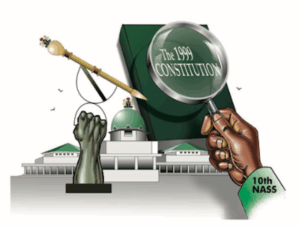
A constitution may be defined as a whole body of fundamental laws, customs, conventions, principles, rules and regulations according to which a particular government of a country or an organization is governed. The constitution therefore specifies the work and functions of a government or organization, the functions of its officials, and the rights and duties of its citizens or members.
SOURCES OF CONSTITUTION
The following are the sources of any given constitution.
- Past experiences: The historical, social, economic, geographical and historical experiences of a country serve as a major source of its constitution.
- Acts of Parliament: These are bills passed into law in the parliament. They also form parts of the constitution.
- Decrees: These are laws made by military governments in many countries.
- Judicial precedence: These are precious and important judgments made or passed in higher courts like the Supreme Court.
- Customs and Norms: These are practices and observances that are not written down as part of the constitution but are accepted as part of the way the government functions.
- Conventions: These are precepts or rules and guides for behaviour that are not written down with which the people show their disapproval when violated.
- Constitutional Conferences: Such constitutional conferences were held in London and West Africa before granting independence to Ghana, Nigeria, Sierra Leone and the Gambia.
- International Laws: These are laws that are made by international organizations like the UNO International Civil Aviation Convention. All serve as sources of the Constitution.
- History of the People: Historical documents such as treaties, the Magna Carta 1215, Bill of Rights 1689 in Britain serve as the sources of their constitution.
- Intellectual Works: The works of intellectuals such as Locke, Marx, Hobbes, Dicey and others are used for the drafting of the Constitution.
FEATURES OF CONSTITUTION
- The Preamble: The Constitution has a preamble or an introduction which states the ideological stand of the Constitution.
- The Political Structure: It states the structure of government, whether unitary or federal and at the same time defines the division of powers among the component units of the state.
- The constitution names the organs of government and specifies their functions and relations to one another.
- It maintains political stability by specifying the mode of changing the government peacefully.
- It stipulates the rights and duties of citizens.
- It protects the rights and liberties of individuals in a country.
- The Constitution states how long a government can stay in office.
- The Constitution states the process by which it can be amended.
- A constitution prevents leaders from becoming too powerful and dictatorial.
- A constitution serves as a symbol of nationhood and sovereignty.
TYPES OF CONSTITUTION
CONTENT
- A written constitution: This refers to a constitution that is written down. The whole body of fundamental laws, customs, conventions, principles, rules and regulations according to which a particular government of a country is governed, are written and codified in a single document.
Examples of countries with a written constitution are Nigeria, USA, India, France, Canada, Sierra Leone, Gambia etc.
FEATURES OF WRITTEN CONSTITUTION
i. It is written down in a single document
ii. A written constitution has a preamble.
iii. It stipulates the method and conditions of its amendment and change.
iv. A written constitution looks very simple because it can be obtained in a single document.
v. It spells out the fundamental human rights and duties of a citizen of a country.
vi. A written constitution is usually rigid.
ADVANTAGES
i. A written constitution can be obtained and consulted as a single document
ii. It has easy reference in case of a dispute
iii. Both lawyers and laymen can get hold of it and read it to know their duties and rights.
iv. A written constitution removes ambiguity normally experienced with an unwritten constitution.
v. It can be amended or changed at any appropriate time.
vi. Minority interests are protected in the constitution.
vii. It ensures stability, defining the powers of government and specifying how they can be exercised thus reducing areas of conflict.
DISADVANTAGES
i. Most written constitutions are rigid and therefore they create problems with amendments.
ii. It may lead to constant disaffection if it does not favour some sections of the country.
iii. Unless a written constitution is frequently amended, it will not meet both the present and the future needs.
iv. A written constitution does not fit all types of government like a unitary system of government.
v. The judiciary may become too powerful because of its power to interpret the Constitution.
vi. It is time-consuming to amend.
vii. It amendment process may be expensive.
- UNWRITTEN CONSTITUTION: An unwritten constitution refers to when the whole body of fundamental laws, customs, conventions, rules, and regulations according to which a particular government of a country operates is not written down or codified in a single document.
Examples of countries with unwritten constitutions are Britain and New Zealand. Some parts of the unwritten constitution may be written down while some may not.
ADVANTAGES
i. Unwritten constitution has a high degree of flexibility which can easily adapt to a country’s changing socio-political and economic situation.
ii. An unwritten constitution makes for easy and quick decisions.
iii. It does not pose problems for amendment.
iv. Its non-rigidity makes for a high degree of compromise between the organs of government.
v. It meets both the present and future needs of a country.
vi. The Constitution can easily be interpreted because of its flexibility.
vii. It is suitable in times of emergency.
DISADVANTAGES
i. It is prone to abuse by the government and individuals since the laws are not codified in one document.
ii. An unwritten constitution can encourage dictatorship.
iii. It does not create room for individuals to know their duties and rights.
iv. It encourages the violation of citizen’s rights.
v. It does not suit a federal system of government.
vi. It does not encourage stability, especially in big countries.
- RIGID CONSTITUTION: A rigid constitution may be defined as that constitution which cannot be amended or changed so easily because of its special stringent and cumbersome procedure of amendment. Rigid constitutions are normally written constitutions but not all written constitutions are rigid. Not all sections of a rigid constitution are difficult to amend.
Examples of countries with a rigid constitution are the USA, Australia, France, Nigeria, Sierra Leone, Gambia etc.
ADVANTAGES OF RIGID CONSTITUTION
i. A rigid constitution is difficult to amend or change and this prevents hasty actions.
ii. It prevents dictatorial leaders from amending the Constitution to serve their dictatorial interests.
iii. It protects the interests of the minority groups.
iv. It ensures political stability in a country because no section can amend the constitution in its favour.
v. It removes constitutional ambiguity.
vi. It allays fears of ethnic domination by the majority groups in a multi-ethnic nation like Nigeria.
DISADVANTAGES
i. Its amendment or change is stringent and cumbersome.
ii. Its inflexibility makes it difficult to take quick actions in times of emergency.
iii. It creates room for revolution or civil war which brings about its violent change or amendment.
iv. It will be very expensive, energy and time-consuming to conduct a referendum for the change or amendment.
v. The amendment of the rigid constitution may lead to slow economic growth and development.
- FLEXIBLE CONSTITUTION: A flexible constitution may be defined as a constitution which can be amended or changed so easily without stringent and cumbersome procedures. It requires a simple majority for a flexible constitution to be amended.
Some flexible constitutions are written, while others are unwritten. Britain, Italy New Zealand, and Ghana are good examples of countries that have flexible constitutions.
ADVANTAGES OF FLEXIBLE CONSTITUTION
i. A flexible constitution is easy to amend.
ii. It is flexible and allows for quick action to be taken in times of emergency.
iii. It does not encourage revolution or civil wars since its flexibility does not make for violent change or amendment.
iv. Its amendment is not expensive, time or energy-consuming.
v. Old constitutional rules can be easily replaced with new ones.
DISADVANTAGES
i. A flexible constitution can be amended hastily and thoughtlessly because it is easy to amend.
ii. It encourages dictatorship because; leaders with dictatorial tendencies can easily amend it to suit their dictatorial whims and caprices.
iii. It does not ensure political stability because one section of the country can easily amend it to its favour.
iv. A flexible constitution is enveloped by constitutional ambiguities
v. It does not allay fears of ethnic domination by the majority ethnic groups in a multi-ethnic nation.
5. FEDERAL CONSTITUTION
CONTENT
A federal constitution refers to one in which governmental powers that exist in the country are shared between a central government that represents the whole country and a government of component states so that each government is legally and constitutionally independent. A country that adopts this type of constitution is known as a federal system of government.
Examples of countries with a federal constitution are the USA, Nigeria, the Federal Republic of Germany, Brazil, Switzerland, Australia, India etc.
FEATURES OF A FEDERAL CONSTITUTION
i. Division of governmental powers among the central government and the component states
ii. It guarantees the supremacy of the constitution.
iii. The different governments derive their powers from the Constitution.
iv. It is always rigid
v. It has judicial interpretation and review.
vi. It allows the bicameral legislature to operate
vii. There is the supremacy of the central government
viii. Duplication of the organs of government exists.
REASONS FOR THE ADOPTION OF A FEDERAL CONSTITUTION
i. It is useful in a multi-ethnic nation
ii. It is used to take care of linguistic differences
iii. It is used to form a federation to unite different groups.
iv. It is used to form a common central government that will guarantee strong security.
v. It is adopted to maintain political stability
vi. It is adopted to take care of the large population
vii. The vast geographical area of a country necessitates the adoption of a federal constitution.
viii. The need for economic stability makes the adoption of a federal constitution to be necessary.
ix. Fear of domination of minority groups by the majority groups makes the adoption of a federal constitution imperative.
x. Fear of external aggression makes the federal constitution necessary
xi. It is adopted to take care of religious differences of the people
xii. It takes care of the racial and cultural differences of the people.
ADVANTAGES OF A FEDERAL CONSTITUTION
i. It unites people of different political, social and geographical areas together
ii. It maintains the independence of the judiciary.
iii. It prevents monopoly of power in a country
iv. It protects the interests of the minority groups.
v. It guarantees strong security in a country.
vi. It makes room for a wider representation of the people.
vii. It allays fear of external aggression
viii. It prevents ethnic domination of the minority by the majority groups.
ix. It maintains political stability among diverse ethnic groups.
x. It encourages healthy competition
xi. It leads to the creation of employment opportunities
xii. It leads to checks and balances thereby preventing tyrannical use of powers.
DISADVANTAGES OF A FEDERAL CONSTITUTION
i. It emphasizes the differences among the different ethnic groups in a country
ii. It creates a weak central government.
iii. Duplication of powers leads to an increase in expenditure.
iv. It increases sectional consciousness.
v. Political rivalry leads to political instability.
vi. It increases secession.
vii. It leads to inflation of population census figures.
viii. It often leads to election rigging.
ix. It creates a problem in the share of the national cake.
- UNITARY CONSTITUTION
CONTENT
A unitary constitution refers to one that concentrates authority in a single central government. It does not share governmental powers with any other subordinate government.
Examples of countries with unitary constitutions are Britain, Belgium, Zealand, Sweden, Sierra Leone, Gambia, etc.
ADVANTAGES OF UNITARY CONSTITUTION
i. It is flexible and therefore easy to amend
ii. Its flexibility allows for quick decisions and action to be taken.
iii. It adapts easily to the changing conditions in a country.
iv. It is less expensive to operate.
v. It creates room for internal stability.
vi. It fosters national unity.
vii. It instils the spirit of nationalism in the citizenry.
viii. It prevents waste of both human and material resources as a result of non-duplication of government
ix. Its non-division of powers and authority makes the central government stronger.
DISADVANTAGES OF UNITARY CONSTITUTION
i. It narrows the scope of political participation.
ii. There is little or no room for local autonomy on customary issues.
iii. It can lead to the emergence of a dictator.
iv. It may not tolerate interest groups.
v. The fundamental human rights of the citizens may not be guaranteed.
vi. The constitution can be easily amended for selfish reasons.
vii. It can lead to abuse of political power.
viii. Domination by a group may engender a tendency for secession.
- CONFEDERAL CONSTITUTION
CONTENT
A Confederal constitution can be defined as one in which almost all major powers and functions of government are reserved exclusively for the component states apart from the common currency, defense and foreign affairs in which the central government may hold power.
Examples of confederacy are Switzerland, Senegal, and Gambia before 1982.
ADVANTAGES OF CONFEDERAL CONSTITUTION
i. There is mutual benefit among member states in different areas of interest.
ii. No member state was forced to become a member of the union since they can secede at any time.
iii. Citizens have to obey only one government, that is, that of their state.
iv. There is unity of states as independent states, big and small, rich and poor are brought together for a common purpose.
v. All the member states which make up the confederation are equal. No state can claim superiority over others.
vi. The component states have full control over their internal affairs.
DISADVANTAGES OF CONFEDERAL CONSTITUTION
i. Confederacies bring about political instability.
ii. There is no effective central authority because a sovereign power cannot be located in a confederation.
iii. There is no spirit of nationalism in a confederation.
iv. The right of members to secede can destabilize and break the union.
v. Confederation is a loose union of sovereign states.
vi. Policies discussed may not be effectively implemented in their respective countries.
ASSIGNMENT
- Explain the following terms; (i) Acts of parliament (ii) Preamble (iii) Judicial precedents
- List and explain the sources of a constitution.
- Highlight 5 features of a constitution.
- Why do some countries adopt written constitutions?
- Outline the major features of the constitution of a state.
- What are the basic features of a flexible constitution?
- Distinguish between constitution and constitutionalism.







